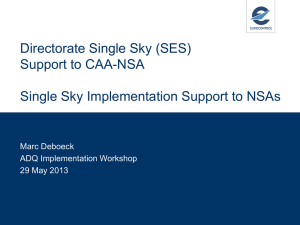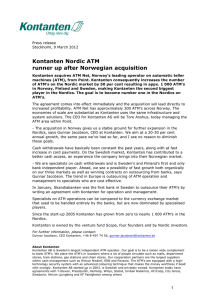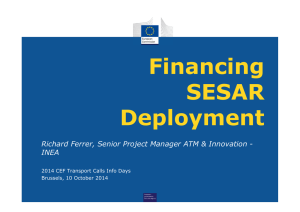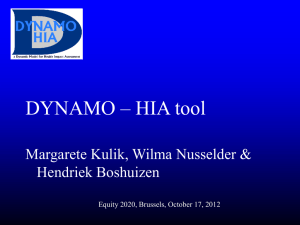Zoran Djuranovic - Regional Cooperation Council
advertisement
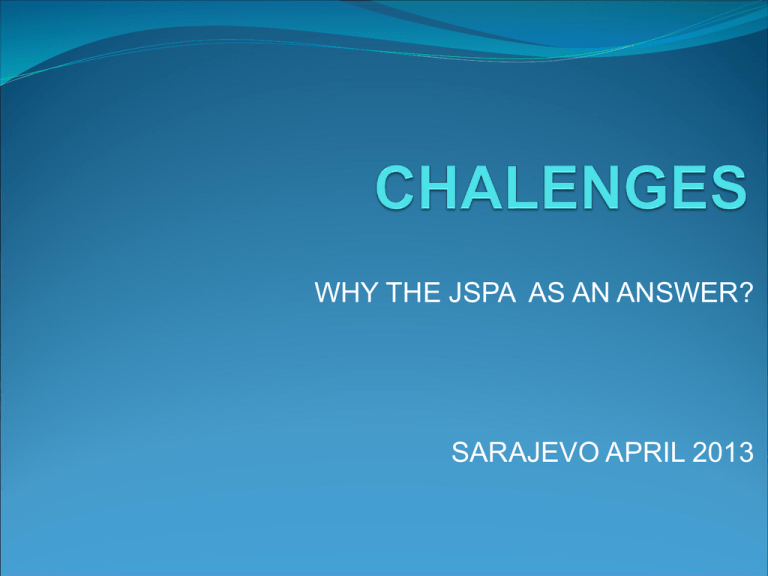
WHY THE JSPA AS AN ANSWER? SARAJEVO APRIL 2013 WHY JSPA? CHANGES in PROGRESS Transport policy objectives Transport policy objectives are set out in the White Paper on Transport «European Transport Policy for 2010: Time to decide» The 2006 mid-term review brought new objectives: • disconnecting mobility from its adverse effects, which means promoting technical innovation • a shift towards the least polluting and most energy efficient modes of transport • above all, co-modality, i.e., optimally combining various modes of transport within the same transport chain Challenges – Main, global Challenges More than ever costs and new techologies will dictate civil aviation environment Satelites will influence every activity in civil aviation Galileo is in the heart of SES concept -----------------------------------------------------Augmentation Systems Aircraft-Based Augmentation System (ABAS) Space-Based Augmentation System (SBAS) Uses geostationary satellites India, Japan, Europe, US Ground-Based Augmentation System (GBAS) Ground-Based Regional System (GRAS) Challenges Our main companions in comming years - Future Air Navigation System(FANS) CPDLC (Controller Pilot Data Link Communication) ADS – C (Automatic Dependent Surveillance Contract) - PM-CPDLC (Protected Mode CPDLC) – Link 2000+ - 4D Trajectories of flights - ADS-B(USA/Australia/Canada/China/Sweden/UAE) Challenges The European Geostationary Navigation Overlay Service (EGNOS) Europe’s Satellite based Augmentation System (SBAS) EGNOS can be used for precision approaches to airports by enabling APV procedures PINS procedures These procedures do not require any conventional ground-based navigation aids, such as VOR, DME or NDB NO COST Performance Based Navigation (PBN) Historically, aircraft navigation specifications have been specified directly in terms of sensors (navigation beacons and/or waypoints). PBN = Navigation technique which allows an aircraft to fly precisely along a predefined route using state-of-the-art onboard navigation systems (Global Positioning System - GPS). This concept is used en route, and can reduce aircraft separation, including the terminal area, and used to optimize arrival and departure procedures. ATM environment The ATM Concept of Operations for 2020 represents a paradigm shift from an airspace-based environment to a trajectory-based environment. The concept is based on: Trajectory management Collaborative planning Integrated airport operations New separation modes System-wide information management Humans central as managers and decision-makers in the future European ATM system ATM and Safety SESAR (and NextGen in the USA) will face safety related challenges in system design, development, certification and regulation As systems become more and more complex, equipment needs to be more and more reliable and safe One of the biggest problem Standards do not exist ATM and Safety The safety of travelling is an absolute prerequisite for air transport, In the current ATM system (as in SESAR), the role of human beings is central, Maintaining safety levels implies a number of challenges for ATM: • Society will increasingly become less tolerant of risks • The ATM profession will have to accept that human error, instead of being the possible cause of incidents, is a direct consequence of constantly operating the ATM system • The economic climate affects safety Technological solutions Airlines want to decrease pollution, and in particular by renewing the fleet of higher-consumption aircraft Manufacturers are producing cleaner aircraft to help reduce emissions, better navigation systems, better use of on-board energy, and optimization systems for taxiing and descending Technological solutions In the years to come, an additional challenge will be the integration of new aircraft into the system, especially when it comes to VLJ (very light jets) VLJ are used because of flexibility or connectivity • • Flexibility relates to air taxi Connectivity relates to linking big cities with smaller ones In the USA 25% of all IFR flights are made by VLJ In Europe, only 10%, but growth of VLJ traffic is twice of that of conventional aircrafts Technological solutions Unmanned Aircraft Systems (UAS) may come to take a potentially high market share, with a wide range of applications such as delivery, search and rescue, and so on… UAS size and performance introduce safety issues: how to ensure separation with other traffic This will call for new safety rules to be developed Technological solutions For the foreseeable future, kerosene will continue to be used - even into the next generation of aircraft There is also significant research into the use of alternative fuels Nuclear energy Emission-free Nuclear waste Pollution Nuclear-based operational concept is probably about 100 years Fuel One of the main challenges for European air transport is the global economy FUEL PRICE Over the long-term, the biggest concern. Without political intervention, a higher fuel price will only reduce air traffic growth for the air transport industry is the cost of fuel Environment Operational solutions for reducing emissions per flight include: • Reducing the speed, and in turn reducing emissions by up to 30% • Choosing better flight levels • Decreasing emissions from ground traffic by reducing waiting time for departure slot or for gate • Planning for more efficient flights, which would consume less energy The ATM community can reduce the environmental impact of aviation by cooperating with airlines to reduce flight inefficiencies Liberalisation The Liberalization in Europe that started in1987 opened the national markets allowing carriers free entrance and market competition in a way of offering greater number of flights and lowering cost of air transport. The Air Navigation Service Providers (i.e. Air Traffic Control) left outside of this process as only link in the value chain organized and operated at the national level. Cost of fragmentation Passengers, airlines and the wider European economy are losing €5 billion every year from inefficient air traffic management. That’s the cost of the fragmentation of European airspace NETWORK Reorganization of Europe’s air traffic network will not guarantee that ANSP improve their efficiency or reduce their costs, or guarantee inter-FAB coordination and cooperation; Impending failure of most FABs to meet their formation deadlines is symptomatic of how the SES programme is failing to deliver the benefits that it should because of pretty birocratic approach. De-fragmenting ANSP and FAB Today, the European sky is controlled by 63 Control centres. The trend is going towards mergers through FAB. ATM cost reduction will be achieved through technical elements like systems harmonization, maintenance, and supervision with economies of scale rather than through service unit and personnel cost reduction. In 2030 there will be the same number of ATCO and service units, even if based on a different organization. ATM will need five to ten years to achieve its defragmentation objective. A third SES package, SESII+ is on the way as support. Goals of SES packages Goal is the implementation of a European high- performance, integrated, network-centric, collaborative and seamless air ground ATM system European airspace will operate as an efficient continuum with two airspace categories Human roles and responsibilities will be more “management task” oriented SES II The Performance Scheme (Commission Regulation (EU) N° 691/2010) and the adoption by the European Commission of the EU-wide performance targets for the reference period 2012-2014 (Commission Decision of 22-02-2011) in areas of cost-efficiency, capacity and environment², requires that the National Supervisory Authorities elaborate national (or FAB-level) performance plans which contribute to the EU-wide performance targets SES II - FAB The Functional Airspace Blocks are bottom-up initiatives led by the States to be established by the end of 2012 ; they aim at an enhanced cooperation between the air navigation service providers (ANSPs) and the national supervisory authorities (NSAs) to de-fragment the airspace and obtain the operational efficiency gains through such strategies as common procurement, training and optimisation of air traffic controllers (ATCs) resources. SES II - Network The Network Manager is a centralized function at EU level to carry out the management of the ATM network functions(airspace design, flow management) and management of scarce resources(transponder code allocations, radio frequencies) as defined in Commission Regulation (EU) N° 677/2011 of 07-07-2011. This function has been entrusted to Eurocontrol up to 2019. SES II - Charging The Charging Regulation (Commission Regulation N° 1191/2010) on the en-route charging system lays down a legal framework of transparent reporting of en-route charges and costs' components of the Member States. It also defines a legal basis for financing, through the charging system, of the "Common Projects" in the context of the deployment of SESAR. SES II - EASA in ATM In conjunction with the approval of the SES regulatory framework, the competences of EASA have been extended to ATM and aerodromes³. EASA is now in charge to develop ATM rules dealing with safety and has started to carry out safety inspections in the field of ATM in 2012. SES II+ - WHY we need JSPA? The European Commission is hoping that the SES II+ package of legislation will prove that third time is lucky. We should strive for global harmonization and simplification of: rules certification operations Outline of the possible guiding objectives of the SESII+ proposal: Improving the performance of air navigation services in terms of efficiency and quality by : Revitalizing the FABs Updating the charging system More efficient performance targets system Outline of the possible guiding objectives of the SESII+ proposal: Improving the current institutional set-up by: Strengthening and supporting the national authorities to guarantee efficient oversight and implementation of rules Clarifying the SES and EASA Frameworks, developing EASA and Eurocontrol Concentrating economic regulation in the Commission, technical regulation and oversight in EASA, with Eurocontrol as a supporting body for these entities. Updating the Network Manager governance One regulator for Europe The Commission sees itself as having control over air transport matters while leaving developmental and operational responsibilities to the industry Means for the EC to be the regulator for non-EU states include: ECAA agreements EUROCONTROL moving into the Community Extending the acquis to non-EU member states. JSPA as the Answer Our New approach (The content and the “speed” to be decided by you) STRATEGY for our Region at least 10 years ahead WHY? OUR motivs should be: - Awareness of very difficult coming period which - requires better provisions, Belifes: about our greater possibilities, we could do better than we did, we can make decisions that will bring benefits in the coming decades, we could be serious partner for respect, partner who can build, not just follow WHY? TO WAIT OR NOT?
